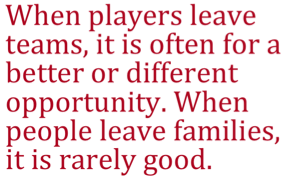This is the Organizational Structure of the Future

The words a company uses to describe itself are critical elements of its culture. Terms like “family” and “team” are loaded with significance related to organizational structure. They reflect priorities and values that are disseminated by leadership across the organization to shape the brand, drive performance, and create value. More importantly, they impact leaders’ ability to evolve and drive change from within.
Businesses striving to be agile and adaptive would do well to look to the sports world.
The Family Business
During the Agricultural and Industrial Ages, the nuclear family was the predominant model. In that era, the ‘family’ business model held particular significance. Companies were tight-knit organizations of people who stayed together for years. This paternalistic structure was designed to engender loyalty, but at times fell into a clan (us/them) mentality.
Today, there are some companies that still position themselves as a family. At the helm is a leadership suite that functions like benevolent, stern parents who lovingly guide those in their charge. Yet, in the current era of decentralized companies and teleworking employees, the family metaphor is losing meaning and value.
Toffler Associates has seen concrete evidence that thinking of the organization as a family unit actually hinders necessary growth and change. When these companies face a transformation that would impact operations or result in the loss of jobs, they endure greater, more personal backlash. If we are family, why are you not taking care of me? How can you get rid of a family member?
All in for the Team Today and Tomorrow
Teams are built to encourage contribution and produce results. Like families, teams have leaders. But they are not there to be parental. They are owners and coaches in positions of authority. They make decisions about daily operations, act in the best interest of the brand, and have expectations of one another and of everyone across the organization. In return, team members know that they can expect certain things from leadership.
In this structure, performance drives results. If someone is not performing, they are benched, traded, or cut. Conversely, if they feel mistreated or undervalued, a team member can sign with a different organization where they can make an impact. Having a role is important. Strong organizations are built on diversity. Leaders recruit to fill needed positions and maintain a pipeline of subs who are prepared to step up whenever they’re called to do so.
With performance driving results, smart teams draft for the future. Owners, coaches, and recruiters select candidates who they train to replace their star players many years before they will assume the role. In doing so, they are Future Proofing® the organization. Every contributing member can enjoy the security of sustained competitive advantage and success.
There is no doubt that deep connections form between team members. Yet, unlike in a ‘family’ business approach where the release or departure of an employee can seem personal, players can leave a team without damaging the relationships.
Peyton Manning’s departure from the Colts is a perfect example. The Colts recognized that Peyton was not the future of the franchise. Team leadership pursued a transformation for the future that included a new player and drafted Andrew Luck. When Peyton moved to continue a successful career in Denver, Indianapolis had talent ready to keep the team moving forward. The situation was a win/win.
 For teams, the focus on performance, talent pipeline, and shared results require that leadership is a shared endeavor. Coaches direct and support their players and fellow coaches. Veteran players are expected contribute experience and help to nurture the younger crop of athletes.
For teams, the focus on performance, talent pipeline, and shared results require that leadership is a shared endeavor. Coaches direct and support their players and fellow coaches. Veteran players are expected contribute experience and help to nurture the younger crop of athletes.
While this is still technically a top-down leadership model, is much less so than is seen in a paternal/family structure. Leadership is earned at every level. It is developed and shared, encouraging accountability and driving performance.
More than ever, today’s companies face an imperative to innovate and remain poised to transform. By building a tight-knit organization that encourages accountability and horizontal leadership, businesses have the best opportunity to build the strength necessary to meet the challenges they will face long into the future.
It’s time to consider and encourage the value of every member of the team.
{{cta(‘befa9ff3-80a5-4a6c-b483-9daadb37b099’)}}
- Categories
- Workforce of the Future
